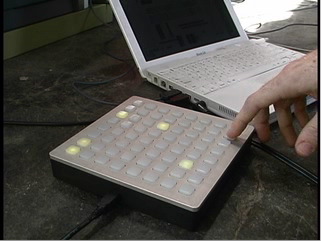The Monome is a new music interface with LED-backlit pads, a USB interface that transmits OSC and MIDI data to a computer, and — here’s the unusual part — open source, hackable firmware and software interface. Touch the pads, and you can use this as a step-sequencer and remix tool (as in the example), but the real philosophy here is being able to do whatever you want, so think of the example video as just a start.

Monome site
Demo video
Product page
Lights and pads: The key design element is making the LEDs and the data from the pads independent. That means you can use the visual feedback on the pads to do whatever you want. So, maybe the LED shows where you are in a loop or step sequence as you play — or maybe it shows something else entirely. In fact, even if you don’t need a box with 256 pads, the idea of abstracting visual feedback from control information for more flexibility is one that could be applied to other instrument designs. (The Lemur, for instance, is also making steps toward letting you provide visual feedback FROM the computer TO the device, the opposite of the usual one-way relationship. There’s a lot more to be done in this area.)
But they’ve also managed to put this in a very professional-looking, USB 2.0-powered box. That’s a big step for a homebrew device. The only disadvantage of the design I can see is that the focus on buttons mean it lacks continuous control, and it’s not velocity-sensitive.
Hackable and Open Source: Mapd, the application that routes MIDI and maps the buttons, will be open sourced soon (apparently useful even if you’re not using this hardware). More importantly, you’ll be able to modify the firmware, so you can add additional controls that aren’t currently on the box (get those soldering irons ready). It’s a big contrast from the hardware and software in other experimental devices like the Lemur, not to mention commercial music hardware. We’ll have to wait to see just how useful this is, but it’s intriguing. The designers also promise to include lots of custom software from artists and tips and tutorials for making it work online.
Where to Get It: If you’re going to the Maker Faire hosted by Make Magazine, the Monome and its creators will be there. (In fact, if you’re going to the Maker Faire, do let me know! Wish I could be there)
Getting your hands on one could be a challenge. US$500 is the price of the first batch; if they sell their lower-quantity batch, though, you could see a more widely-produced model and lower prices. Our friend Chris O’Shea gets the scoop on this one (thanks, Chris). Also on the CDM forums.